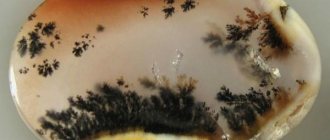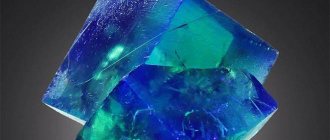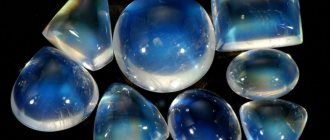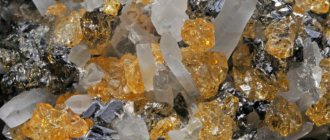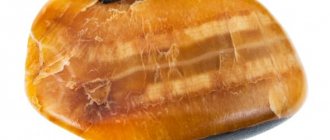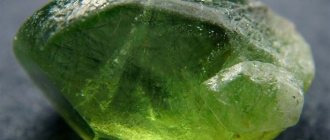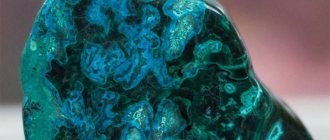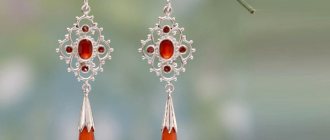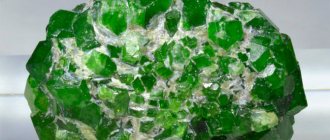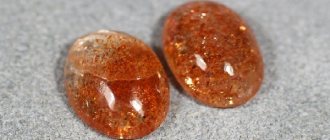What is a stone
The term “microcline” is a common name for several minerals:
- The most popular varieties: amazonite, aventurine, heliolite, pegmatite. Each has its own composition, formula, price.
- These are stones of varying degrees of transparency with a glassy or mother-of-pearl sheen to a silky shine.
- Color – white, green, yellow, blue, indigo, orange, brown, golden.
Some stones are endowed with the property of iridescence (rainbow tints on the surface).
Production (field)
Microcline formation occurs according to several algorithms in areas of igneous rocks, pegmatites or microclinites (metasomatites):
- In temperature conditions below 500 C by changing the crystal lattice of the residual compositions of rocks. This type is called homogeneous.
- Formed by subsequent recrystallization from previously formed potassium feldspar, called sanidine. This mineral belongs to the category of lattice microclines.
Associated minerals: albite, quartz, nepheline
Possible associations: quartz, columbite, albite, siderite, fluorite, clevelandite. The most common are the accretion of microcline particles with quartz, which are called written granite.
In Russia, the largest deposits of nuggets are located on the western White Sea coast, in North Karelia. Feldspar is mined there together with quartz rocks and mica. The Kola Peninsula is known for its wealth of amazonite representatives, pure emerald color. Small deposits are also located in Eastern Siberia.
The largest microcline producing countries:
- Germany;
- Switzerland;
- Norway;
- Ukraine;
- Kazakhstan;
- Poland;
- USA;
- Japan.
Physico-chemical characteristics
The chemical formula of microcline is complex, as is its composition.
For a chemist, it is a silicate. Minerologists classify the stone as potassium feldspars of hydrothermal or metamorphic origin.
| Color | colorless, white, gray, grayish-yellow, yellowish, tan, salmon pink, brownish-red, bluish-green, green, sometimes iridescent |
| Stroke color | white |
| origin of name | From the Greek micro - small and wedge - angle, since the cleavage angle of a microcline differs from a right angle by only 20′ |
| Opening place | Arendal, Aust-Agder, Norway Stavern (Fredriksvärn), Larvik, Vestfold, Norway |
| Opening year | 1830 |
| IMA status | valid, first described before 1959 (before IMA) |
| Chemical formula | K[AlSi3O8] |
| Shine | glass |
| Transparency | transparent translucent translucent |
| Cleavage | perfect by {001} perfect by {010} |
| Kink | uneven |
| Hardness | 6 6,5 |
| Thermal properties | P. tr. melts with difficulty |
| Typical impurities | Fe,Ca,Na,Li,Cs,Rb,H2O,Pb |
| Strunz (8th edition) | 8/J.06-30 |
| Hey's CIM Ref. | 16.3.5 |
| Dana (8th edition) | 76.1.1.5 |
| Molecular weight | 278.33 |
| Cell Options | a = 8.5784Å, b = 12.96Å, c = 7.2112Å α = 90.3°, β = 116.05°, γ = 89° |
| Attitude | a:b:c = 0.662 : 1 : 0.556 |
| Number of formula units (Z) | 4 |
| Unit cell volume | V 720.16 ų |
| Twinning | Carlsbad, Baven, polysynthetic twins. Characteristic are intersecting polysynthetic systems. dv. according to the albite and pericline laws, forming the so-called. micro wedge grid |
| Point group | 1 - Pinacoidal |
| Space group | C/1 |
| Separateness | by {100}, {110}, {110}, {201} |
| Radioactivity (GRapi) | 200.97 |
| Density (calculated) | 2.56 |
| Density (measured) | 2.54 — 2.57 |
| Optical axis dispersion | r > v weak |
| Refractive indices | nα = 1.514 - 1.529 nβ = 1.518 - 1.533 nγ = 1.521 - 1.539 |
| Maximum birefringence | δ = 0.007 - 0.010 |
| Type | biaxial (-) |
| angle 2V | measured: 66° to 103°, calculated: 80° |
| Optical relief | short |
| Selection form | short-prismatic or tabular crystals, often of considerable size, granular masses, phenocrysts, ovoids; graphic intergrowths with quartz |
| Classes on taxonomy of the USSR | Silicates |
| IMA classes | Silicates |
| singonia | triclinic |
| Fragility | Yes |
| Irisation | Yes |
Impurities create a color palette.
Physical properties
| Property | Description |
| singonia | triclinic |
| Color | transparent, white, blue, green, yellow, orange, brown, golden |
| Transparency | translucent, transparent, translucent |
| Hardness | 6.5 Mohs |
| Density | 2.5 g\cm3 |
| Shine | glass, mother-of-pearl |
| Fragility | Yes |
| Surface | rough |
| Cleavage | perfect |
| Kink | uneven |
| Molecular weight | 278 |
| Irisation | Yes |
| Crystals | tabular, prismatic, pseudotetragonal |
Where is it used?
The mineral microcline has found application in industry, jewelry and decorative arts:
- Opaque raw materials are used as a source of glass, ceramics, and electrode coating. It is valued by manufacturers of tableware, industrial products (insulators), and dentists (fillings, crowns).
- Amazonite is used to make tiles, slabs for window sills and mantelpieces. But wealthy people can buy them.
- The best samples go to jewelers. The stone is processed into a cabochon, turning beads for necklaces, bracelets, and rosaries. Products made from microcline with iridescence and emerald green amazonites are prized.
Amazonite ring
Well-formed microcline crystals with quartz inclusions are a collector's dream. Because of its patterned surface, this stone is known as “written” granite. Connoisseurs are not deterred by its exorbitant price or rarity. A classic of collectible art – amazonite intergrowths with smoky quartz.
Mineral deposits
Microcline rocks are formed in pegmatites and granites, and are mined in many countries around the world. The largest developments of the mineral are carried out in European countries (Switzerland, Poland, Norway, Germany, Ukraine), post-Soviet countries (Kazakhstan and Russia), as well as in Japan, the USA and Madagascar.
The Kola Peninsula of Russia is famous for its amazonite deposits; high-quality heliolite and aventurine feldspar are mined in Siberia and the Urals; in the southern regions of the Urals, Karelia and the Altai Territory there are deposits of graphic pegmatite.
Precious Amazonite is also mined in Brazil, Namibia, India and most US states. High-quality “sunstone” crystals are developed in Canadian deposits located in the vicinity of the St. Hilary mountain range. Back to contents
How to identify a fake
Microcline is counterfeited by selling plastic or glass under its guise. It is easy to recognize such an imitation:
- lightweight;
- not particularly cold;
- heats up quickly in your hands;
- devoid of iridescence.
Microcline has a non-metallic luster and iridescence; it scratches glass.
Orthoclase and microcline are often confused. Visually, they look identical; only a gemologist using special equipment can distinguish one from the other.
Place of Birth
The size of its individual specimens can reach several tons. Microcline is a rock-forming mineral for granites and pegmatites. The stone crystals have the shape of a rectangular prism. Sometimes prisms grow together to form a group of crystals.
In Russia, microcline is mined in the Urals and Karelia. Among the world's countries rich in this mineral, we can note Norway (Hundholmen), Kazakhstan (Kentau), Switzerland (Tessin canton), Germany (Müden), Ukraine (Volyn, Azov region), USA (Arkansas and Colorado).
Therapeutic effect
Lithotherapists have established the healing effects of the stone:
- Heals the heart and blood vessels.
- Helps with rheumatism, varicose veins, arthritis.
- Relieves pain from osteochondrosis.
- Improves vision.
- Neutralizes depression, anxiety, aggressiveness.
Jewelry with green microcline (amazonite) is worn when there is a threat of physical exhaustion or emotional burnout.
Stone therapists use heated rollers or stones for massage.
Indian healers associate it with the heart chakra.
Microcline
Microcline is one of the most common minerals belonging to the subclass of framework silicates and to the group of potassium feldspars. The mineral contains a small amount of sodium oxide. The percentage of other compounds in the mineral is as follows: potassium oxide - 16.93%; aluminum oxide - 18.35%; silicon oxide – 64.72%.
The chemical formula of the mineral is (K, Na). Translated from Greek, the word “mikros” means small, and the word “klino” means slope. The name of the mineral is associated with the angle located between the cleavage planes, which deviates from the right angle by 20 degrees. One of the varieties of microcline is amazonite, a mineral that has a green or bluish-green color.
Crystals of the mineral are represented by a short-prismatic and tabular structure. Their size in granite pegmatites sometimes reaches 2-3 meters. The mineral is also found in the form of massive crystalline formations. Microcline hardness – 6-6.5; specific gravity is approximately 2.6. The fracture is uneven. Perfect cleavage is characteristic. Translucent. Has a glassy sheen. Triclinic syngony. A special feature of the mineral is that it contains inclusions of albite.
The color of the mineral is quite varied. It can be yellow, pink, gray, bright red, white, green, brown, brown. The variety of colors is due to the many impurities that make up the mineral. These are barium, sodium, iron, cesium, lead, rubidium.
Microcline formation occurs during magmatic, metamorphic, metasomatic and hydrothermal processes. Pegmatites contain deposits of the mineral together with plagioclase, quartz, micas, and hydrothermal veins - together with quartz, wolframite, cassiterite. The largest deposits of the mineral are known in Russia - in the Urals, on the Kola Peninsula, in Karelia, as well as abroad - in Switzerland, Japan, Poland, the USA, Germany, Norway.
The popular graphic pegmatite, which is a type of microcline, is used as an ornamental stone. It has been known since ancient times. An interesting feature is that the surface of graphic pegmatite resembles Jewish writing, which is why it received its second name - “written granite”. Microcline is an aluminous additive in glass batch, which is used for the production of earthenware and porcelain.
The jewelry industry mainly uses a variety of microcline - amazonite, which is an amazingly beautiful mineral due to its green or green-blue color. Wonderful jewelry is made from it, and it is also used as an ornamental stone for various products - boxes, vases, etc. The resulting intergrowths of rectangular prisms of mineral crystals of extraordinary beauty are of great interest and high value to collectors. Samples of the mineral of an orange-red hue with crystals of dazzling shine cause a parasitic effect.
Amazonite is known to have healing and magical properties. It relieves headaches, epileptic seizures, and also helps a person get out of depression. Amazonite improves family relationships and attracts material wealth to the home.
published by Tatyana | | publish your article
| Tweet |
<< previous stone next stone >>
Magic properties
Esotericists consider the main magical property of microcline to be a positive effect on a person’s internal “microclimate”:
- The magic of Amazonite will eliminate family troubles and bring peace to the home. It is enough to place any pebble in the room (away from prying eyes).
- Relationships with other people are supervised by heliolite. It should be placed on your desk or given to your boss.
Heliolite stone - Pegmatite has talismanic significance for anyone who studies or conducts research.
Pegmatite pebbles are taken for interviews, castings, negotiations, and other important events. Suitable as an ally for any piece of jewelry.
Varieties of microcline
The mineral has many varieties, different in color, structure and application.
- Amazonite is an ornamental and jewelry stone of turquoise shades, the structure of which almost always contains albite. Mineral deposits of igneous origin are found in pegmatites and granites.
- Graphic pegmatite is one of the varieties of potassium feldspar, the peculiarity of which is regularly located ingrown quartz crystals, reminiscent of Arabic or Jewish hieroglyphs when cut. Thanks to this, the mineral received the name “Jewish stone”.
- Heliolite is a transparent or translucent “sunny” stone, shimmering in orange, crimson, and golden hues. Externally, the mineral is similar to aventurine quartz, however, compared to the latter, it has a granular structure and greater fragility.
- Aventurine feldspar is an opaque golden heliolite with red-orange, honey and pink hues.
Application
A photo of a microcline is unlikely to amaze you with its incredible beauty, but this mineral is often used in jewelry. It is cut into cabochons or used as an ornamental stone. The zonal coloring and rough texture of the mineral give products made from it a special chic.
Micro wedge is widely used for making ceramic tiles
Microcline is also used in industry. Excellent porcelain and earthenware products are made from it. The high strength and visual appeal of this stone makes the mineral an excellent facing stone.
